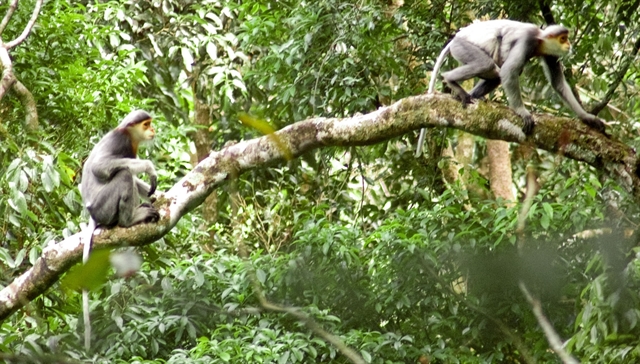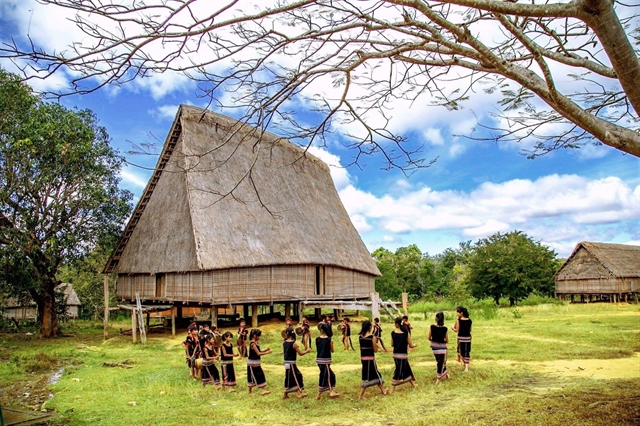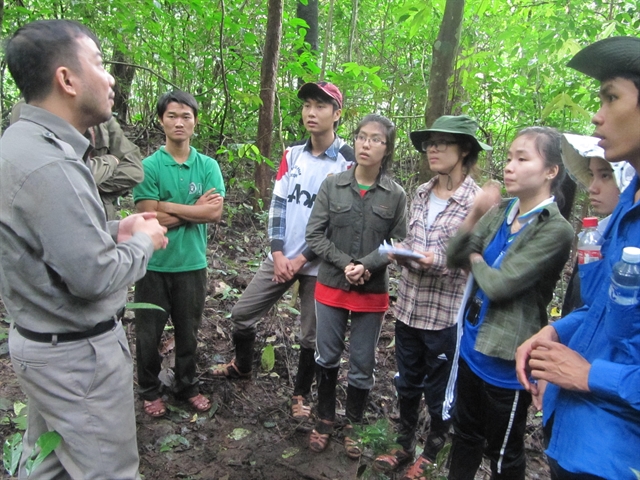The central highlands Gia Lai province, in co-operation with Man and the Biosphere Programme, an intergovernmental scientific programme of UNESCO, has completed a dossier for the World Biosphere Reserve recognition of Kon Hà Nừng Highlands.

Two gray-shanked douc langurs (pygathrix cinerea) – the world's largest troop living in the central region of Việt Nam - are found living in the national Kon Ka Kinh Park in Gia Lai Province. The province has sent a dossier for the World Biosphere Reserve recognition of Kon Hà Nừng Highlands in the province. Photo courtesy of Frankfurt Zoological Society
A total area of 413,511ha of Kon Ka Kinh National Park and Kon Chư Răng natural reserve is discussed in the dossier.
The central provincial sub-department of forest protection confirmed to Việt Nam News the preparatory works, which had been built in 2018-20, was sent to UNESCO last September for approval.
It said the UNESCO recognition of the reserve would help protect and preserve the rich biodiversity of the unique site, boosting eco-tourism and community livelihoods as well as attract international scientific research.
The world reserve will include two core zones of Kon Ka Kinh National Park and Kon Chư Răng natural reserve on 57,493ha, and a 152,693ha buffer zone covering districts and communes of Đắk Đoa, Mang Yang, K’Bang, Chư Păh, Đắk Pơ and An Khê township of the province.
Dr. Hà Thăng Long, head of the representative office of the Frankfurt Zoological Society in Việt Nam said the site will be a key centre of natural scenery protection helping critically endangered species and precious gene conservation.

Ethnic Ba Na group preserve their culture and lifestyle in connection with the protection of forests in Gia Lai Province. Photo courtesy Lê Văn Cảnh
He said Kon Ka Kinh National Park had been a safe haven for about 250 gray-shanked douc langurs (pygathrix cinerea) – the world's largest troop living in the central region of Việt Nam.
These animals are among the world's 25 critically endangered primates according to the International Union for Conservation of Nature (IUNC) Red List.
"The park is also home to three kinds of monkey (Macaca leonia, Macaca artoides and Macara mulatta), two species of loris (Nycticebus bengalensis and Nycticebus pygmaeus) and gibbons (Nomascus leucogienys leucogienys), he said.
Conservationists also found and recorded the existence of chestnut-eared laughing thrush (Garrulax konkakinhensis), a rare species of bird, in the park.
Some endangered species were recorded in the area including agarwood (Aquilaria crassna); Giant Muntjac (Megamuntiacus vuquangensis), Trường Sơn Muntjac (Muntiacus trươngsonensis), Northern buffered-cheeked gibbon (Nomascus annamensis), Austen’s brown hornbill (Anorrhinus austeni); Crested argus (Rheinardia ocellata), Silver Pheasant (Lophura nycthemera)

Dr Hà Thăng Long (left) gives a lecture to a group of students during a field study trip in the jungle of the central highlands region. VNS Photo Công Thành
Kon Ka Kinh, which was one of five national parks in Việt Nam, and one of 27 national parks being recognised as ASEAN Heritage Park in 2003, plays an important role in the protection of the area upstream the Ba River and the Dak Pne River, which supply water for crops in Gia Lai and Kon Tum provinces.
The Frankfurt Zoological Society's Việt Nam Primate Conservation Programme have pursued a long-term conservation, protection and education programme on the gray-shanked douc langur in the park since 2006.
Việt Nam has eight world biosphere reserves, but no natural forest in the central highlands region has been awarded the world recognition by UNESCO